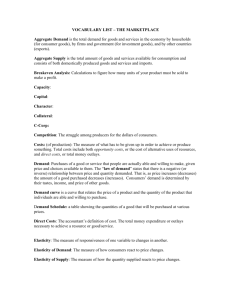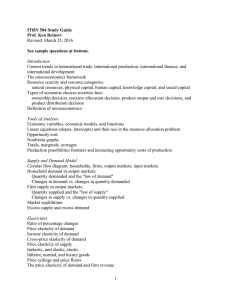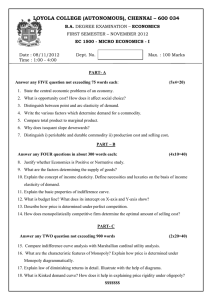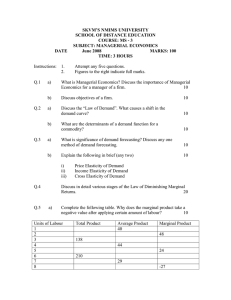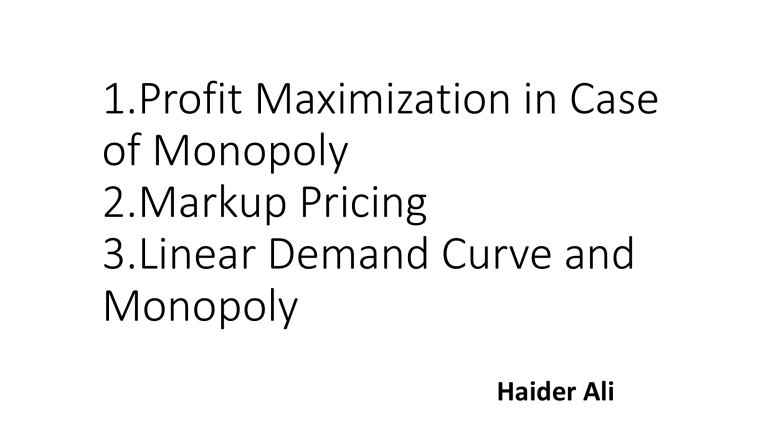
1.Profit Maximization in Case of Monopoly 2.Markup Pricing 3.Linear Demand Curve and Monopoly Haider Ali Choosing Suitable Quantity to Maximize Profit Profit Maximization • Profit Maximization problem • Let us 𝑝 𝑦 Market Inverse Demand Curve • 𝑐 𝑦 Cost Function 𝑟 𝑦 = 𝑝 𝑦 𝑦 Revenue function • Profit maximization 𝑚𝑎𝑥𝑦 𝑟 𝑦 − 𝑐(𝑦) Optimality Condition 𝑴𝑹 = 𝑴𝑪 ∆𝑟 ∆𝑐 = ∆𝑦 ∆𝑦 If MR<MC , Firms will decrease output and vice versa. Output Decision • If monopolist decides to increase its output by ∆𝑦 , there will be two effects on revenues • 1.Selling more output and earning revenue of 𝑝∆𝑦. • 2. It will lower its price by ∆𝑝 and will get this lower price on all the output he is selling. 𝑟 = 𝑝𝑦 𝑟 ′ = 𝑝 + ∆𝑝 𝑦 + ∆𝑦 Subtracting r from r’, ∆𝒓 = 𝒑∆𝒚 + 𝒚∆𝒑 ∆𝒓 ∆𝒑 =𝒑+ 𝐲 ∆𝒚 ∆𝒚 By rearranging above equation we get 𝑀𝑅(𝑦) 1 =𝑝 𝑦 1+ 𝜖 𝑦 1 𝑝 𝑦 1+ = 𝑀𝐶(𝑦) 𝜖 𝑦 Since elasticity is naturally negative that’s why we can also write it in the following way. 1 𝑝 𝑦 1− 𝜖 𝑦 = 𝑀𝐶(𝑦) In case of Perfect Comopetition Demand curve is flat i.e infinitively elastic demand curve, in this case P=MC. Markup Pricing 𝑀𝐶 𝑦 1 =𝑝 𝑦 1− 𝜖(𝑦) 𝑀𝐶(𝑦∗ ) 𝑝 𝑦 = 1 1− 𝜖(𝑦) Markup is given by 𝟏 𝟏 𝟏− 𝝐(𝒚 Numerical Example • Suppose elasticity is constant i.e 𝜖 = 3. • By using markup formula , markup will be equal to 1.5. • A monopolist who faces a constant elasticity of demand will charge a price that is a constant mark-up (which is 1.5 when e = 3) on MC. This is illustrated in Figure. Linear Demand Curve and Monopoly Linear demand curve 𝑝 𝑦 = 𝑎 − 𝑏𝑦 Revenue Function 𝑟 𝑦 = 𝑝 𝑦 𝑦 = 𝑎𝑦 − 𝑏𝑦 2 . Marginal Revenue Function 𝑀𝑅(𝑦) = 𝑎 − 2𝑏𝑦.
